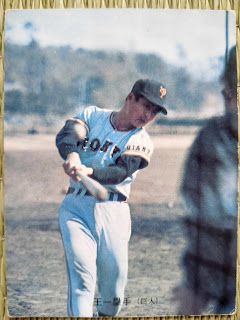Collecting and Translating the 1973 Calbee Bat-Backs (Part 1)
1973 Calbee #5 (bat-back) and #6 (flag-back)
This post marks the first chronicling my quest to collect and translate all the 1973 Calbee “bat-back” cards. ‘73 was the first year the Calbee snack food company issued its still-ongoing baseball cards, with these bat-backs representing the very first off the line. The 91 odd cards by number (more exist by way of variations), prelude an expanded “flag-back” set of 368 cards. This complete ‘73 Calbee set (in which all the original bat-backs were reprinted as flag-backs) is functionally impossible to complete because of its dozens of mythical super-short printed cards which can go for hundreds of dollars even in poor condition—when they actually surface. The original bat-backs, therefore, offer a more realistic (but still very tough) alternative.
It appears still unconfirmed whether the bat-backs served as an actual test issue or if a decision was simply made to change the backs to the flag design and reprint and incorporate the already released bat-backs into an expanded set. What is known is that the printing and release of the bat-backs was done in two series, or “blocks” to use the Japanese terminology. Block 1 consists of cards #1-72; Block 2, cards #73-91. Of the 72 Block 1 cards, the first 50 are Yomiuri Giants players. The rest of Block 1 and all of Block 2—cards #51-91—are of players from other teams.
I recently got the 2003 book Calbee Pro Baseball Cards 1973 by Yoshinori Mori (after authoring a book so comprehensive and informative I suppose Mori-san can be forgiven for not coming up with a snappy title). The book confirmed my suspicion about the bat-back cards—that some are far more common than others. According to Mori, Block 1, in addition to being issued nationwide, had 53 of its cards reprinted with the release of Block 2. Based on my own eye test, I assume these cards to be all of the Giants cards (#1-50) as well as #51, 52, and 53. On the other hand, not only were bat-backs from Block 2 not reprinted at all, they were only released in Western Japan (crucially, not Tokyo) rather than nationally. Based on this, here's a rough breakdown of rarity among bat-backs (these classifications are my own, not Mori’s):
● Common: Block 1 cards #1-53. Nearly all Giants. Nationwide release. Reprinted.
● Uncommon: Block 1 cards #54-72. Non-Giants players. Nationwide release. Not reprinted.
● Rare: Block 2 cards #73-91 Non-Giants players. Released in Western Japan only. Not reprinted.
As of writing this article my checklist aligns pretty neatly with this breakdown. I currently have 85% of the commons, 37% of the uncommons, and 11% of the rares.
It should also be mentioned that there are '73 Calbees rarer than even the Block 2 'Rare' cards, but these are all within the greater flag-back set. Certain cards within the set were released only very locally. Others are image variations of existing cards and also saw limited release. Since these 'Super Rares' only come in flag-back, they will not have any bearing on this bat-back run.
Starting in numerical order with the lowest numbered cards I currently have, these five all feature either Shigeo Nagashima or Sadaharu Oh. The two Giants immortals unsurprisingly get first billing in the set, with Nagashima taking #1-6 and Oh, #7-12. Although commons, these first twelve come at a comparative premium given the stature of the players, with the iconic #1 generally fetching hundreds.
#4 Nagashima - Third Baseman (Giants)
This is a great looking card that charts Nagashima’s career home run pace with a fastidiousness particular to Japanese baseball.
Nagashima's Home Run Pace
#5 Nagashima - Third Baseman (Giants)
Nagashima's Ability As A Hitter
In college (Rikkyo University), Nagashima rewrote the record books as a home run hitter. Since joining the Giants he's been smashing them as a pro. It's been said that a player as great as him comes once in a decade. To understand the difference between Nagashima and other players, consider how Nagashima, even if his form is off, will still excel with an almost animalistic instinct for getting the bat on the ball.
#8 Oh - First Baseman (Giants)
Oh's second Calbee card overall isn't very eye catching, but the candid shot is still nice. A good mix of posed and action photography characterizes the '73 Calbee set. Here Oh is given the same treatment as Nagashima (#4) with a chart of his home run milestones.
Oh's Home Run Record
#9 Oh - First Baseman (Giants)
This card suffers from poor photography, although there is something poetic about Oh's famous flamingo stance being instantly recognizable despite the murky image. I imagine that he, much like Ichiro, must have looked distinct in the batter's box even from the nosebleed. This card has a super rare image variation featuring a similar image of Oh zoomed in and with better lighting.























Thanks for the translations! My experience has been similar to your, the second block is much more difficult to find and when I do find them, they are typically flag back
ReplyDeleteYou bet. I'm glad you mentioned the point about the second block cards being typically flag back. Mori actually addresses this in his book. For the bat backs, #1-72 are more common than #73-91, but the opposite is actually true for the flag backs. #73-91 flag backs exist in higher quantities than #1-72. He calls it the 'Bat Version-Flag Version Reversal Phenomenon.'
Delete